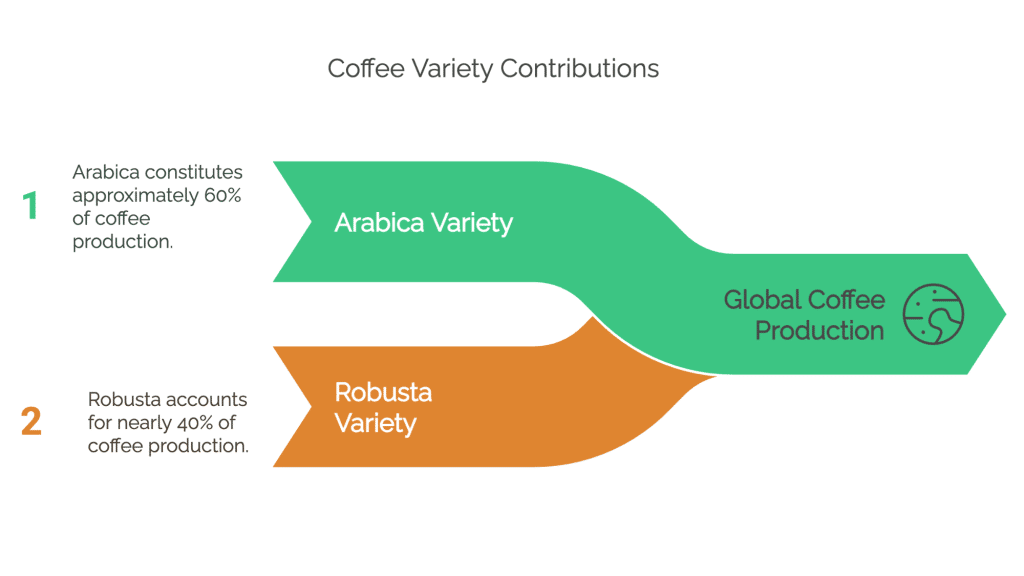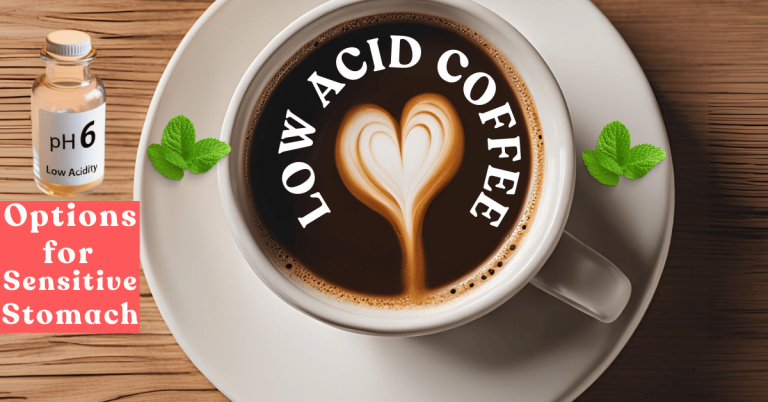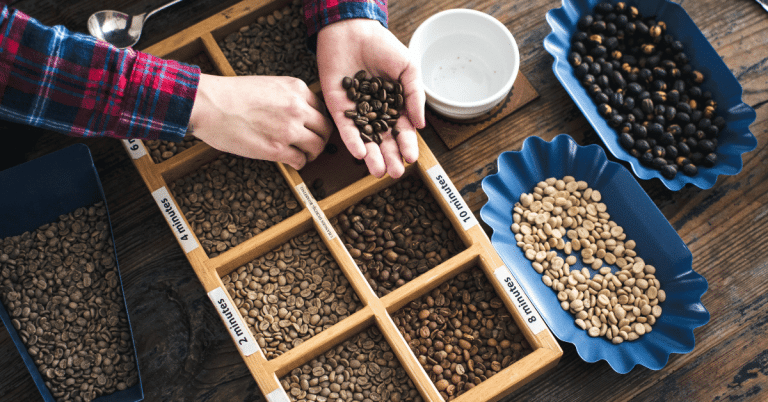The Ultimate Guide to Arabica vs. Robusta Coffee Beans

Coffee lovers around the world face a fundamental choice when selecting their beans: Arabica or Robusta? While you might recognize these names from your favorite coffee shop menu, understanding the distinct characteristics of each can transform your coffee experience!
Did you know that Arabica accounts for about 60% of global coffee production, while Robusta makes up nearly all of the remaining 40%?
In this comprehensive guide, we’ll dive into the fascinating world of coffee beans, exploring everything from flavor profiles to growing conditions.
Whether you’re a casual coffee drinker or an aspiring barista, this comparison will help you make more informed choices about your daily brew!
The Origins and History of Arabica and Robusta Coffee
I still remember the moment I fell down the coffee rabbit hole. It was after I married and my better half hooked me on instant coffee. My curiosity was instantly piqued, unaware of the fact that there’s a world of coffee beans too!
Trace the Discovery of Arabica Beans in Ethiopia and their Spread throughout the World
Arabica coffee’s story begins in the southwestern highlands of Ethiopia, where it grew wild for centuries before humans caught on. Legend has it that a goat herder named Kaldi discovered coffee when his goats became unusually energetic after eating some mysterious red berries.
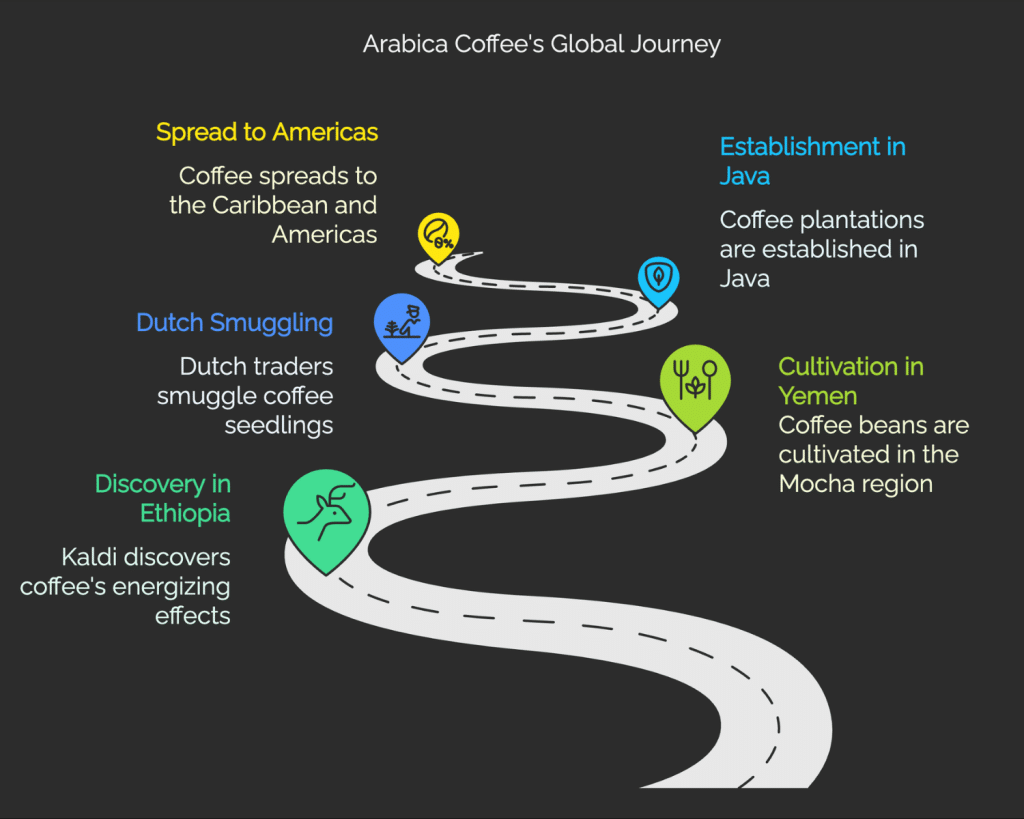
Whether that’s true or not, we do know that locals were consuming coffee in some form by the 15th century.
What fascinates me most about Arabica’s journey is how it spread beyond Ethiopia. The beans made their way to Yemen around the 15th century, where they were cultivated in the Mocha region (yep, that’s where the name comes from!). The Arabs were seriously protective of their coffee plants – they actually boiled or roasted the seeds before export to prevent cultivation elsewhere. Clever, but not foolproof.
Around 1616, Dutch traders smuggled some live coffee seedlings out of the Arabian Peninsula. This act of agricultural espionage changed everything! They established plantations in their colonies, including Java (another familiar coffee name). From there, Arabica spread to the Caribbean, Central and South America throughout the 17th and 18th centuries.
Explore the Later Discovery of Robusta Beans in Central Africa
Robusta coffee has a very different origin story. It wasn’t until the late 19th century that this caffeine powerhouse was discovered growing wild in the Congo Basin of central Africa. Compared to its fancy cousin Arabica, Robusta is the tough kid on the block – more disease-resistant, higher in caffeine, and able to grow at lower elevations.
How Colonialism affected the Global Distribution of different Coffee Varieties
The colonial powers played a huge role in spreading coffee cultivation. When coffee leaf rust decimated Ceylon’s (now Sri Lanka) coffee plantations in the 1870s, the British switched to tea production there while intensifying coffee cultivation in their African colonies. France, Portugal, and other colonial powers similarly established coffee plantations in their territories, often using forced labor – definitely one of the darker chapters in coffee’s history.
Evolution of Coffee Growing Regions and How they Specialize in different Bean Types
Climate and geography have shaped where different varieties thrive. Arabica prefers high altitudes and mild temperatures, which is why countries like Colombia, Ethiopia, and parts of Central America specialize in these beans. Robusta thrives in hotter, more humid lowland areas like Vietnam and parts of Brazil.
It’s amazing to see how coffee farms in both Guatemala and Vietnam have different approaches! The Guatemalan farmers are all about their shade-grown Arabica, while the Vietnamese producers are crushing it with sun-grown Robusta. Each region has adapted their growing methods based on their specific bean type and local conditions.
Today’s specialty coffee market mostly favors Arabica for its complex flavors, but Robusta has its devoted fans too – especially for espresso blends where its extra punch of caffeine and rich crema are highly valued.
I personally keep both in my kitchen for different brewing methods. For a fun and creamy twist using instant coffee, try this easy dalgona coffee recipe — a frothy treat that went viral for good reason.
When I’m making my morning pour-over, it’s Arabica all the way. But when I need a serious kick to power through a deadline? Hello, Robusta espresso!
Key Differences in Growing Conditions and Cultivation
The world of coffee cultivation is truly a tale of two beans. I’ve virtually witnessed when I worked for a coffee certification scheme how dramatically different Arabica and Robusta are to grow. These aren’t just minor variations – they’re completely different plants with unique needs! While they’re botanical cousins in the Coffea genus, they might as well be from different planets when it comes to cultivation requirements.
Understanding these differences isn’t just coffee trivia – it’s crucial knowledge that impacts everything from global trade to your daily brew quality. Farmers make or break their livelihoods based on choosing the right variety for their specific growing conditions. And I’ve made plenty of mistakes in my own coffee experiments over the years!
Let’s dive into what makes these beans so different from a cultivation standpoint. Trust me, after understanding these fundamentals, you’ll have a different approach to your coffee cup.
Altitude Requirements: A Matter of Elevation
When I first started learning about coffee cultivation, the altitude differences between Arabica and Robusta surprised me. Arabica is definitely the high-altitude diva, thriving between 600-2000+ masl (meters above sea level). These elevation requirements aren’t just coffee fundamentals – the higher altitudes slow bean development, allowing more complex flavors to develop.
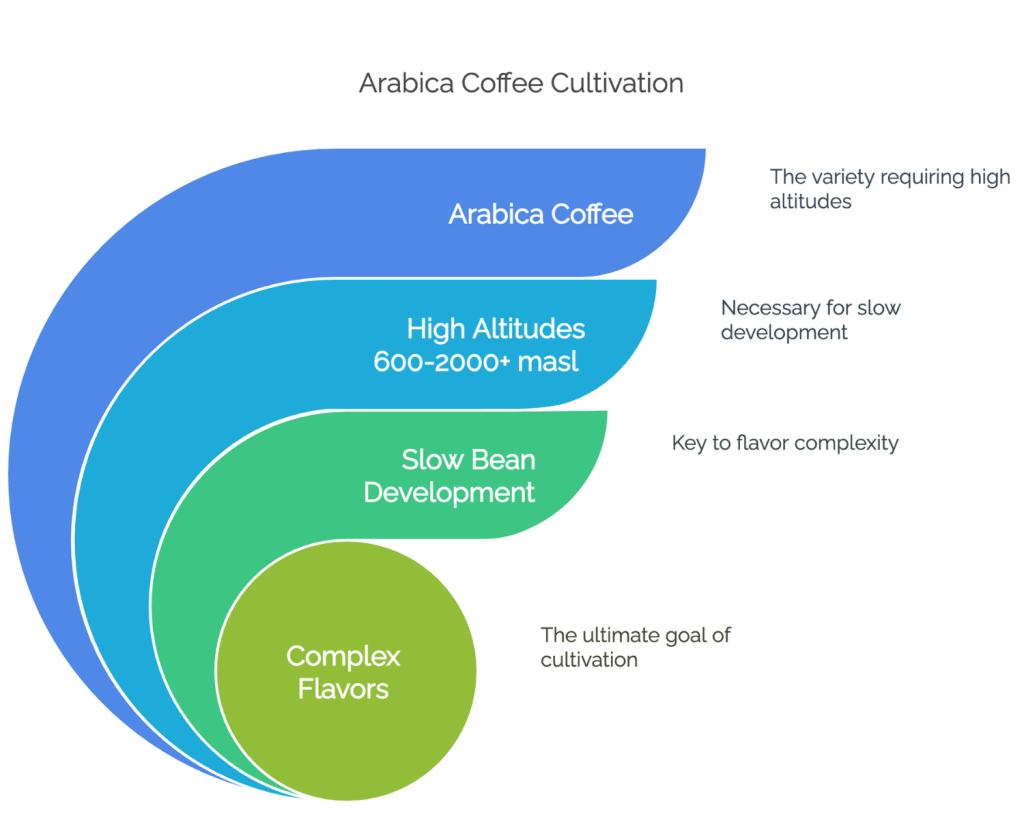
I’ve met Colombian coffee experts who proudly pointed out how their 1800m elevation produced more nuanced flavors than farms just a few hundred meters lower.
Temperature Preferences: The Climate Factor
The temperature needs of these coffee varieties couldn’t be more different! Arabica is pretty finicky, preferring a mild, consistent climate between 15-24°C (59-75°F).
Robusta, on the other hand, can handle the heat like a champ, thriving in temperatures up to 30°C (86°F). This temperature tolerance is one reason why Vietnam, with its hotter climate, became the world’s Robusta powerhouse.
Disease Resistance: The Battle Against Coffee Leaf Rust
Robusta’s natural hardiness makes it significantly more disease-resistant than its delicate cousin.
In 2012, a significant outbreak of coffee leaf rust in southeastern Mexico led to the loss of 10 to 55 percent of Arabica coffee crops throughout Central America over the subsequent three years. This epidemic severely affected coffee production and jeopardized the livelihoods of smallholder farmers and workers in the region.
On the flip side, nearby Robusta plants stood tall and unbothered. Robusta naturally contains about 2-3 times more caffeine than Arabica, which actually acts as a natural insect repellent. Pretty cool how the same thing that wakes us up also protects the plant!
Growing Regions: A Global Coffee Map
The global distribution of coffee varieties tells the story of their environmental preferences. Arabica dominates in places like Ethiopia (its ancestral home), Colombia, parts of Brazil, Guatemala, and Costa Rica – regions with higher elevations and milder temperatures.

I’ve tasted coffees from each of these regions, and the terroir differences are fascinating! Robusta, meanwhile, rules in Vietnam (the world’s largest Robusta producer), parts of Brazil, Uganda, and Indonesia. These regions typically feature lower elevations and warmer climates that would stress out Arabica plants.
Yield and Maturation: The Waiting Game
One thing many coffee enthusiasts don’t realize is how differently these plants produce. Robusta trees generally yield more coffee cherries and mature faster than Arabica plants. In contrast, Robusta trees produce nearly twice the volume of cherries compared to similar-sized Arabica plants.
For farmers, this productivity difference can be crucial to their livelihood, even though Arabica typically commands higher prices per pound.
Water Requirements: Thirsty Work
The water needs between these varieties also differ substantially. Arabica plants need consistent rainfall spread throughout the year (about 1500-2000mm annually).
Robusta can handle more variable conditions including both drought and excess rainfall, making it more adaptable to unpredictable weather patterns – increasingly important in our changing climate.
Flavor Profiles: Tasting the Difference
After years of mindlessly slurping whatever coffee was available, I finally understood why people get so passionate about their preferences.
Arabica’s Complex Symphony
Arabica beans are the darlings of specialty coffee for good reason. Their flavor profile is like a complex piece of music with multiple instruments playing in harmony. The first time I properly tasted a high-quality Panamanian Arabica, I was shocked by the bright acidity—something like a ripe mandarin and white grape — that danced on my palate. This acidity gives Arabica its lively, vibrant character that makes your mouth water.
What really sets Arabica apart is its sweetness and aromatics. Good Arabica has natural sweetness reminiscent of brown sugar, honey, or caramel. And the aromatic compounds? They’re incredible! Curious how roasting affects taste? Dive into our guide on coffee bean roast levels to understand the science behind light, medium, and dark roasts.
Depending on the origin, you might detect floral notes like jasmine or rose, fruit flavors from berries to stone fruits, or even chocolate and nuts.
I bought a Panamanian Gesha that smelled like lychee, rose and tasted like pear and honey—mind-blowing stuff that commanded $70 per pound!
Robusta’s Bold Statement
Robusta makes a completely different statement. The first time I tasted pure, quality Robusta, I was struck by its powerful presence—it doesn’t whisper, it shouts! The flavor profile is typically described as bold, earthy, and nutty with pronounced bitterness. That bitterness isn’t necessarily bad; it’s more like dark chocolate or walnuts than something unpleasant.
What surprised me about Robusta was its distinct grain-like quality, sometimes reminiscent of toasted cereals or peanuts. The body is heavier too—creating that thick, rich mouthfeel that espresso lovers crave.
And while Robusta gets criticized for lacking complexity, specialty-grade Robusta can have interesting hints of dark chocolate, wood, and even rum-like notes. Its higher caffeine content (nearly double that of Arabica) also contributes to its distinctive bite.
Processing Magic
The way coffee cherries are processed after harvest dramatically impacts flavor profiles of both varieties. I’ve tasted the same coffee processed three different ways, and it’s like they came from different planets!
Natural (dry) processing, where the cherry dries around the bean, tends to create fruitier flavors—sometimes with a delightful fermented quality that reminds me of wine or whiskey.
Washed (wet) processing, which removes the fruit before drying, typically results in cleaner, brighter flavors that highlight the bean’s intrinsic characteristics. I particularly love washed Arabicas for their clarity and precision of flavor. And if you’re mindful of sourcing and sustainability, you might enjoy some of these organic instant coffee options that balance ethics and flavor.
Honey processing—a middle path where some fruit remains during drying—creates unique sweetness profiles that can be magical with the right beans.
To add, different instant coffee forms also affect taste — here’s a helpful breakdown of instant coffee crystals vs powder.
Brewing Method Matters
Different brewing methods can highlight or mask the distinctive qualities of these beans. For showcasing Arabica’s complex flavors,
I’ve found pour-over methods like Chemex or V60 to be unbeatable—they’re like high-definition flavor displays. The clean extraction and paper filtration let you taste all those subtle notes that might get lost in other methods. I wouldn’t lie, this is debatable with fellow coffee enthusiasts.
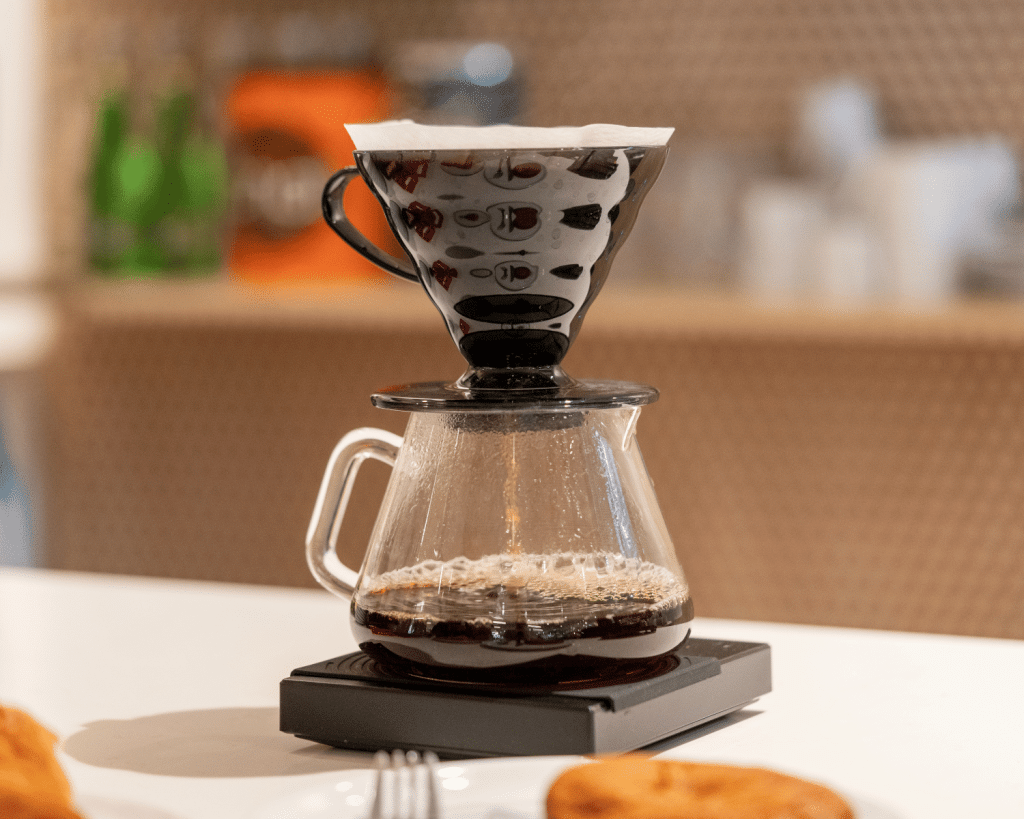
Robusta, with its bold profile and greater solubility, often shines in methods that apply pressure—espresso or moka pot. The pressure extracts the rich oils and creates that creamy mouthfeel that Robusta is known for. I’ve become a fan of using quality Robusta in my espresso blends specifically for the incredible crema it produces.
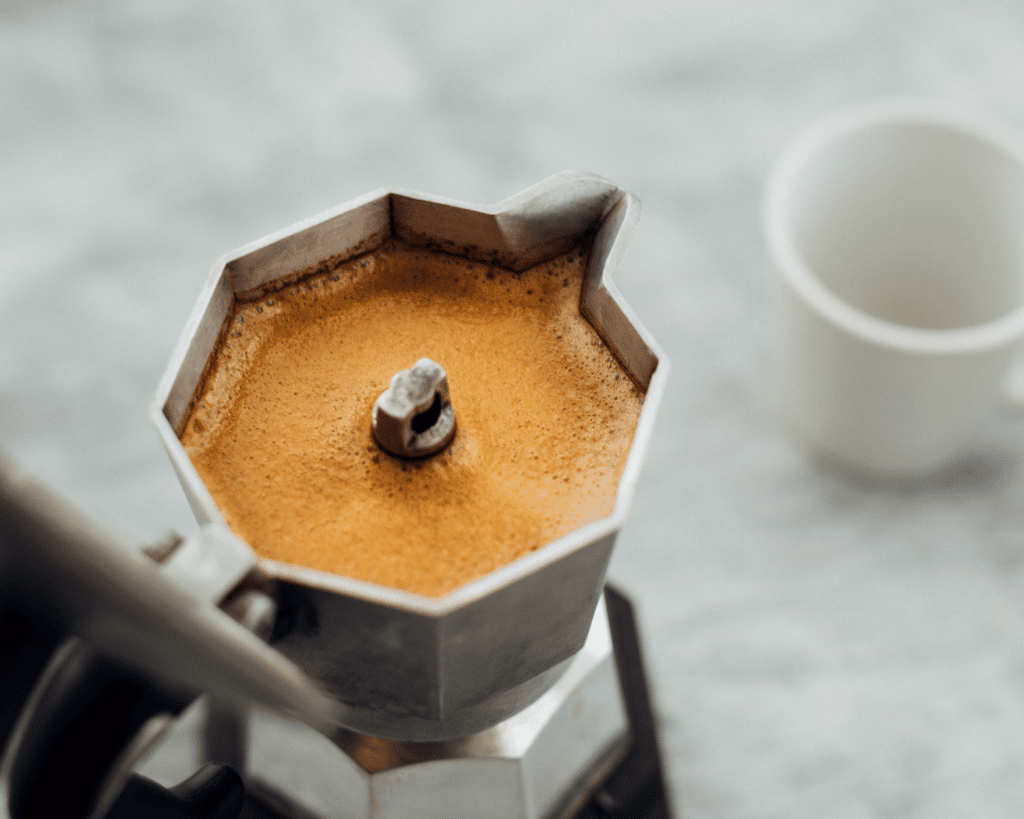
That rich golden-brown foam creates a textural experience that pure Arabica sometimes struggles to match. And if you’re experimenting with espresso-style drinks at home, instant espresso powder can be a convenient way to achieve that rich flavor.
One mistake I made early in my coffee journey was brewing Arabica using methods designed for Robusta, and vice versa. It’s like trying to make a sports car perform like an off-road vehicle! Each bean has its strengths, and matching the brewing method to the bean type makes a world of difference in your cup quality.
Popular Coffee Blends: When Arabica Meets Robusta
The “Arabica vs. Robusta” debate dominated my coffee conversations for years until I realized something important – they’re often better together! Like many coffee lovers, I was late to the party to start as an Arabica purist, turning my nose up at anything containing Robusta.
After experiencing properly crafted blends from master roasters, I’ve come to appreciate the magic that happens when these beans join forces.
The Espresso Connection
The marriage of Arabica and Robusta in espresso blends is where I first appreciated their complementary relationship. Traditional Italian espresso blends typically contain 10-40% Robusta, and there’s solid science behind this. My first truly exceptional espresso experience was trying a Lavazza Super Crema Whole Bean Espresso Coffee (Medium Roast).
The Italian coffee giant has their spin at this signature blend using 40% Robusta from Indonesia and Vietnam to create that perfect crema – the rich, caramel-colored foam that marks a quality shot.
Robusta contributes body, crema, and punch to espresso blends while Arabica brings complexity and sweetness. Think of Arabica as providing the melody while Robusta delivers the bass notes. When pulled through an espresso machine, the pressure extraction highlights Robusta’s strengths while minimizing its potential harshness.
I’ve tried pulling shots with 100% Arabica, and while delicious, they often lack that distinctive richness that defines traditional espresso.
Famous Marriages Around the World
Some of the world’s most beloved coffee blends incorporate both varieties. Lavazza’s Super Crema (Italy) contains around 40% Robusta and has converted many of my Arabica-only friends. The Vietnamese classic “ca phe sua da” (iced coffee with condensed milk) typically uses 100% Robusta, creating a bold profile that stands up beautifully to the sweetness of condensed milk.
Want to recreate a chilled brew at home? Here’s how to make iced instant coffee that tastes like a café-quality drink.
In India, the famous Monsoon Malabar coffees sometimes blend both beans to capitalize on the unique processing method where beans are exposed to monsoon winds and moisture for several months.
When to Go Pure
Despite my appreciation for blends, there are definitely times when single-variety coffees shine brightest. For pour-over and filter methods, I generally prefer 100% Arabica from a single origin. The clean extraction lets you appreciate the bean’s terroir – those distinctive flavor notes that reflect the growing region. Ethiopian Yirgacheffe prepared as a pour-over remains one of life’s great pleasures!
On the flip side, a high-quality 100% Robusta can be impressive in certain applications. I tried specialty-grade Robusta from Indonesia that was mind-blowing as an Indonesian-style coffee. Its woody, wild fruit flavor profile came through beautifully, and the caffeine kick was perfect for particularly challenging start-of-the-week mornings.
Understanding these blending principles has transformed my home coffee game. Instead of chasing only the most expensive single-origin beans, I’ve learned to appreciate thoughtfully crafted blends that often deliver more balanced, interesting cups than either variety could achieve alone.
If you’re exploring brewing methods and wondering how different formats affect taste and convenience, check out this guide on instant coffee vs ground coffee.
How to Choose Between Arabica and Robusta for Your Brew
Choosing the right coffee bean can feel like navigating a maze blindfolded. Trust me, I’ve been there! After years of experimentation trying different varieties, I’ve finally figured out how to match beans to my mood, brewing method, and budget. Let me share what I’ve learned about making this choice easier.
Understanding Your Flavor Preferences
Your taste buds should be the ultimate guide in this decision. When I first started my coffee journey, I thought I needed to force myself to appreciate whatever the coffee experts recommended. While I respect their opinion but not all that they recommend works for me! I’ve since learned to trust my palate.
If you enjoy subtle, complex flavors with bright acidity and fruity or floral notes, Arabica is your go-to bean. My morning grind involves a light-roasted Ethiopian Arabica Ethiopia – Alo Village Archers Lot Honey that tastes like lavender, bergamot, mandarine, peach, green tea – it’s like dessert in a cup! Arabica tends to have a smoother, sweeter profile with less bitterness, making it perfect for those who enjoy tasting the nuanced differences between origins.
On the other hand, if you crave a bold, strong cup with pronounced bitterness and a hefty caffeine kick, Robusta might be your match. My father-in-law exclusively drinks Robusta because he wants coffee that “puts hair on your chest” (his words, not mine). The nutty, earthy flavors stand up beautifully to milk and sugar, which is why many traditional Italian espresso blends incorporate some percentage of Robusta.
Budget Realities
Let’s talk money, because coffee habits can get expensive! Arabica generally costs 2-3 times more than Robusta, and that price difference is noticeable when you’re brewing daily. Let’s look at the consumer spending on Arabica versus Robusta coffee beans. This is reflective of notable differences in market share, pricing, and regional preferences:
Arabica Beans: In 2025, Arabica beans are projected to account for approximately 69.3% of the global coffee bean market. This dominance is attributed to premiumization trends among coffee drinkers globally.
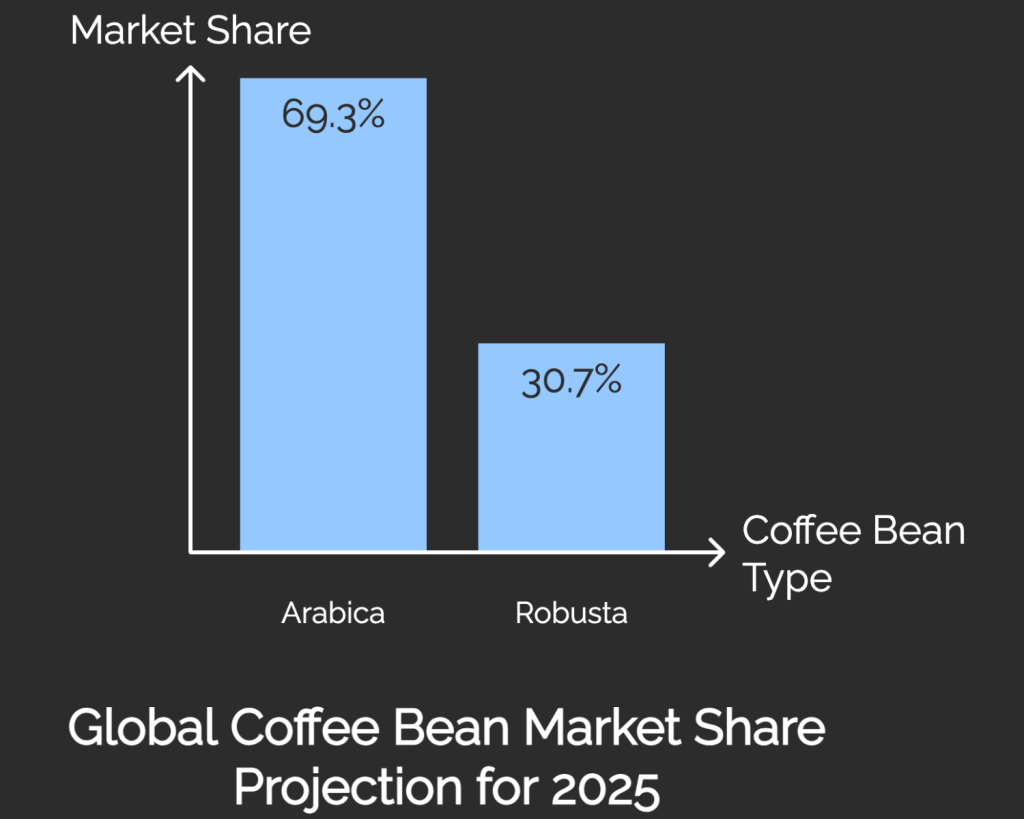
Robusta Beans: Consequently, Robusta beans represent about 30.7% of the market. Robusta’s share is bolstered by its use in instant coffee and espresso blends, as well as its resilience to pests and diseases, making it a staple in certain markets.
Price Comparison
- Arabica: As of 2025, Arabica coffee prices are higher, reflecting its premium status. Arabica beans are projected to increase in price to $4.80 per kilogram by 2026.
- Robusta: Robusta beans are generally more affordable. In early 2025, Robusta prices peaked at $5,847 per metric ton, equivalent to approximately $5.85 per kilogram.
Regional Preferences
- United States: U.S. consumers show a strong preference for Arabica beans, with imports increasing by 9.8% from 2017 to 2022. This trend underscores the American market’s inclination towards higher-quality coffee.
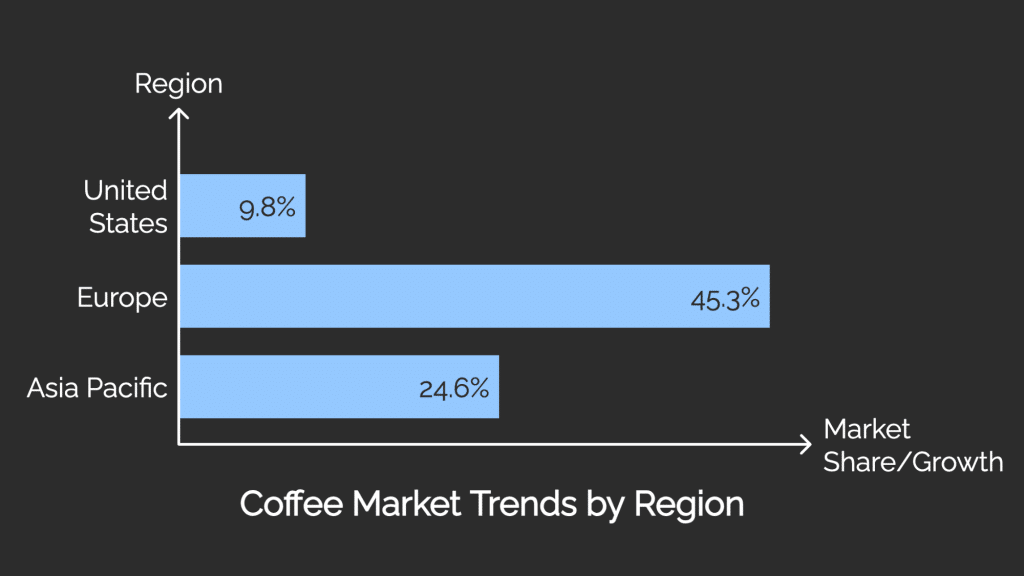
- Europe: Europe is expected to lead the global coffee market, accounting for 45.3% of the market share in 2025. The region’s well-established coffee culture and robust consumer demand contribute to this dominance.
- Asia Pacific: The Asia Pacific region is projected to capture 24.6% of the market share in 2025, showcasing the fastest growth globally. This expansion is driven by countries such as China and India, where increasing incomes and a flourishing coffee culture are key factors.
Market Outlook
The global coffee beans market, encompassing both Arabica and Robusta, is estimated to be valued at $58.53 billion by the end of 2025. The market is expected to reach $90.03 billion by 2032, exhibiting a compound annual growth rate (CAGR) of 6.3% from 2025 to 2032.
Don’t fall into the trap of assuming all Arabica is superior just because it’s more expensive – there’s plenty of low-quality Arabica flooding the market.
Decision Flowchart: Finding Your Perfect Bean
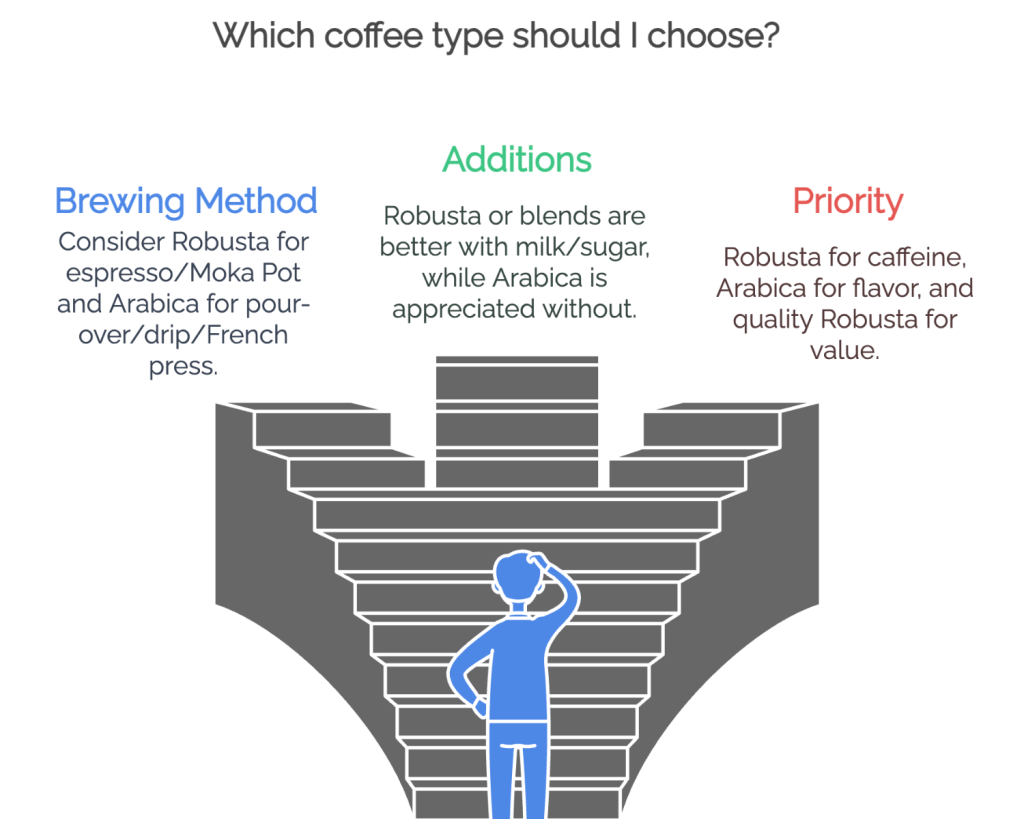
When helping friends choose coffee, I walk them through these questions:
- How do you brew your coffee most often?
- Espresso/Moka Pot → Consider blends with some Robusta content
- Pour-over/Drip/French Press → Lean toward Arabica
- Do you add milk or sugar?
- Yes, always → Robusta or blends stand up better to additions
- Sometimes or never → Arabica’s subtleties will be more appreciated
- What’s your priority?
- Maximum caffeine → Robusta (nearly double the caffeine)
- Complex flavor → Arabica
- Value for money → Quality Robusta or blends
- What flavors do you enjoy?
- Fruity, floral, wine-like → Arabica
- Bold, nutty, chocolatey → Robusta or darker-roasted Arabica
Don’t get too caught up in the Arabica vs. Robusta debate. The best coffee is the one that makes YOU happy.
Experiment, trust your taste buds, and remember that even coffee experts appreciate both varieties when they’re quality-sourced and properly roasted. The perfect cup is the one that brings you joy, regardless of which bean it comes from!
Debunking Common Myths About Arabica and Robusta
The coffee industry has perpetuated this myth that Arabica is inherently superior, but that’s oversimplifying things drastically.
The “Arabica is Always Superior” Fallacy
What I’ve learned after visiting different countries across three continents is that bean quality exists on a spectrum. An expertly grown, carefully processed specialty Robusta can absolutely outshine a mediocre or poorly handled Arabica.
The truth is, there’s incredible variation within each species. Just like how not all wines of the same grape variety taste the same, coffee beans vary tremendously based on terroir, processing, and handling.
Caffeine Content Confusion
Robusta tastes bitter because it has more caffeine – I’ve heard this simplification countless times. While Robusta does contain approximately twice the caffeine of Arabica (about 2.7% vs 1.5% by weight), the relationship between caffeine and flavor is more complicated.
If you’re sensitive to acidity, certain low acid instant coffee options may provide a gentler experience while still delivering a satisfying brew.
A study led by Dr. Thomas Hofmann at the Technical University of Munich found that caffeine contributes only about 15% of coffee’s perceived bitterness.
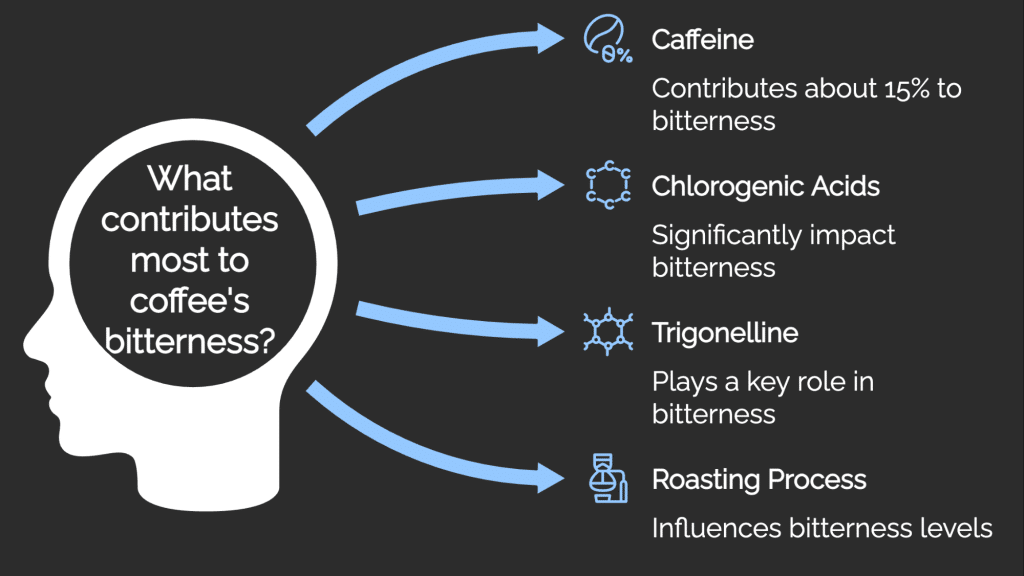
What actually impacts bitterness more significantly are chlorogenic acids, trigonelline, and how the beans are roasted.
I’ve tasted high-caffeine Robustas that were remarkably smooth, and Arabicas that were surprisingly bitter despite lower caffeine content. The caffeine-bitterness connection is partially true but wildly overstated.
The Price-Quality Misconception
One persistent myth that cost me a lot of money when I started exploring coffee was equating price with quality. I’ve purchased $70/pound “premium” Arabicas that were stale or poorly roasted, and $12/pound Robustas that were exceptional. The truth? Price reflects many factors beyond quality – including scarcity, marketing, and consumer perception.
What really opened my eyes was learning about how geography affects pricing. Some regions command premium prices based on reputation alone, regardless of the actual cup quality.
Meanwhile, areas newer to specialty coffee (like some parts of Asia and Africa producing excellent Robusta) haven’t yet established the reputation to demand top dollar, creating some amazing values for knowledgeable consumers.
The “Robusta is Just for Cheap Blends” Myth
For years, I believed Robusta was just filler used to cut costs in commercial blends. This couldn’t be further from the truth! Quality Robusta plays a crucial role in creating the perfect crema in espresso and providing body and punch that stands up to milk in cappuccinos and lattes. There’s a reason traditional Italian espresso blends typically include 10-40% Robusta – it’s not about cutting costs but about creating a specific flavor profile.
For example, Tonino Lamborghini’s Red Blend consists of 80% Arabica and 20% Robusta, aiming to balance sophistication with boldness.
Regional Growing Restrictions
Another myth I embarrassingly repeated for years was that “Robusta can only grow in lowland areas and Arabica only at high elevations.” While there are general altitude preferences, the boundaries are far more blurred than many realize.
Robusta coffee in Uganda is cultivated at elevations ranging from 1,000 to 1,500 meters above sea level, which is relatively high for this species. This is facilitated by Uganda’s unique climate and soil conditions, allowing Robusta to flourish at these altitudes and Arabica varieties are specially bred for lower elevations.
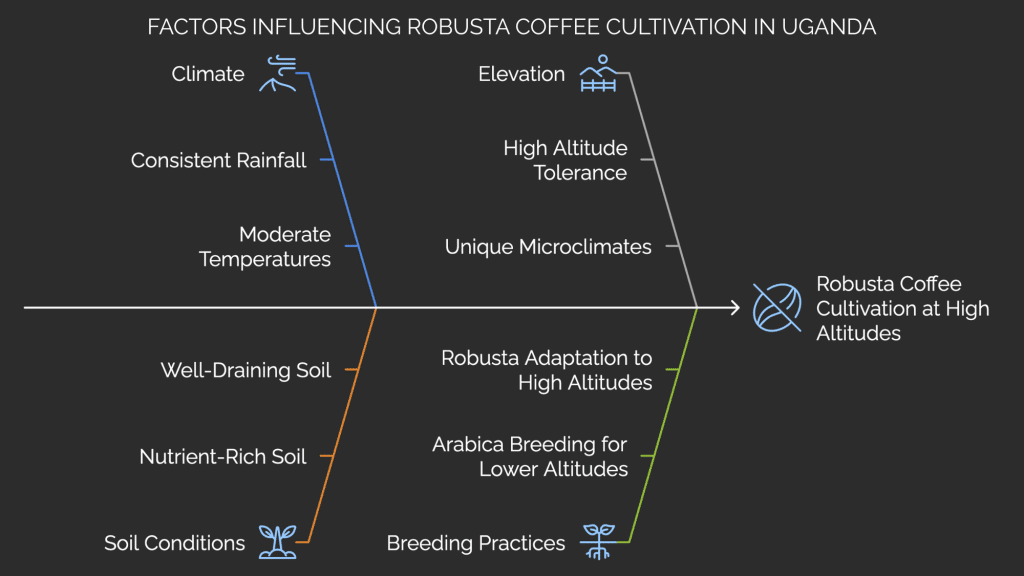
Climate change is further challenging these traditional boundaries. Colombian farmers are experimenting with Robusta plots at higher elevations than traditionally thought possible – an adaptation to warming temperatures affecting their Arabica crops. The geography of coffee is constantly evolving, making strict regional rules increasingly outdated.
The coffee world is full of these oversimplified myths that do a disservice to both bean varieties. My advice trust your own taste buds over marketing claims, be open to having your assumptions challenged, and remember that exceptional coffee comes in many forms – sometimes where you least expect it.
Conclusion
After exploring the fascinating differences between Arabica and Robusta coffee beans, it’s clear that each variety offers unique characteristics worth appreciating. While Arabica tends to deliver more complex and nuanced flavors that many specialty coffee enthusiasts prefer, Robusta brings its own strengths with higher caffeine content, greater body, and excellent crema for espresso.
The “better” bean ultimately depends on your personal preferences, brewing method, and how you enjoy your coffee.
I encourage you to experiment with both varieties—perhaps even try some carefully crafted blends that combine the best of both worlds! Whatever your choice, understanding these fundamental differences will enhance your appreciation of your next cup of coffee!
Frequently Asked Questions
Which coffee bean is smoother—Arabica or Robusta?
Arabica beans are smoother and often less bitter. If you like mellow, sweet coffee, Arabica’s your go-to. Robusta is bolder and packs more punch.
Is Robusta coffee stronger than Arabica?
Yep! Robusta has nearly twice the caffeine of Arabica. It’s ideal if you need a strong morning boost—but it can taste a bit harsher.
What’s better for espresso—Arabica or Robusta?
A blend of both works best. Arabica gives smoothness and aroma, while Robusta adds crema and boldness. Many espresso blends mix the two.
Which bean is more budget-friendly?
Robusta is usually cheaper. If you’re brewing on a budget, it’s a solid pick. Arabica costs more but offers a richer, more complex flavor.
How can I tell if my coffee is Arabica or Robusta?
Check the label—most premium brands list the bean type. Arabica beans are oval with a curved crease; Robusta is rounder and straight-lined.

